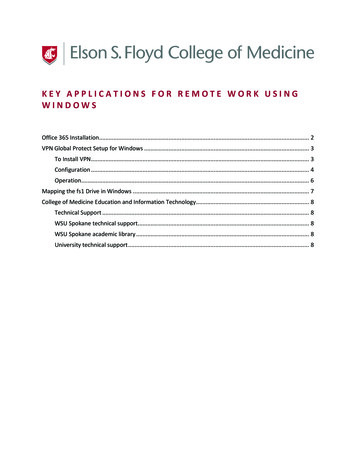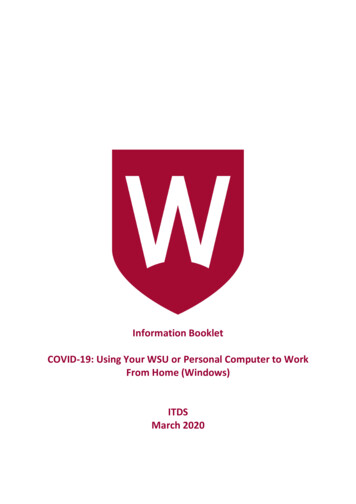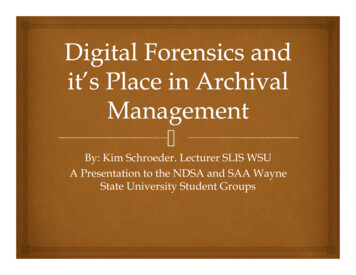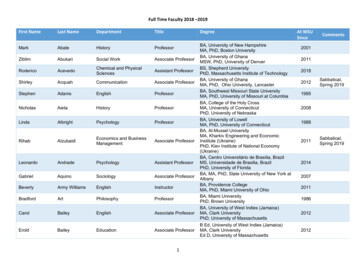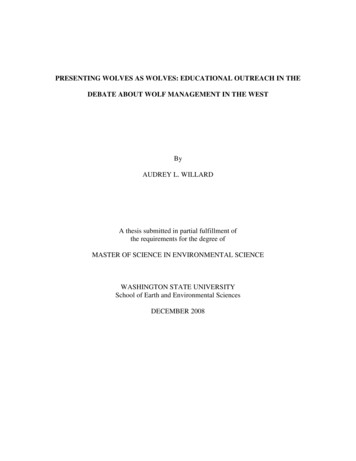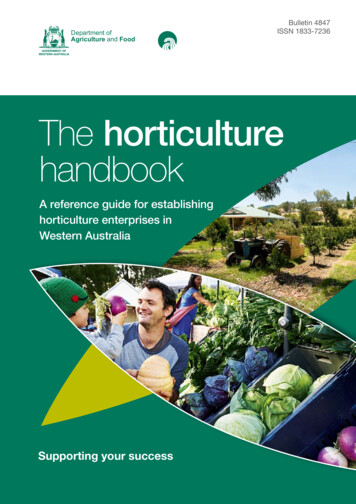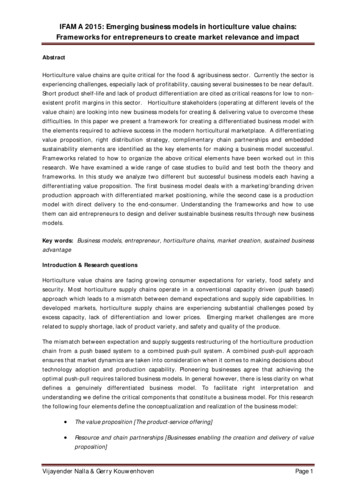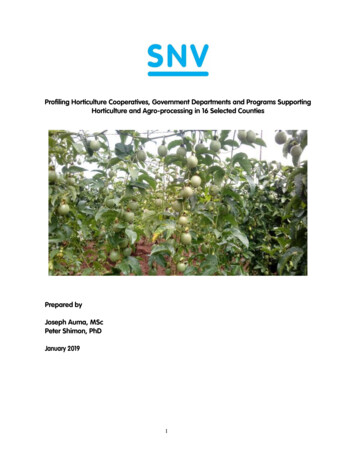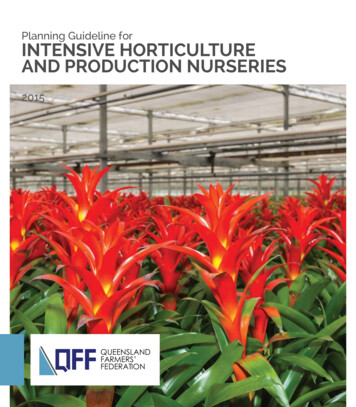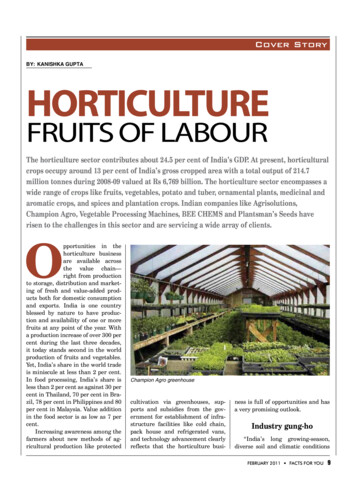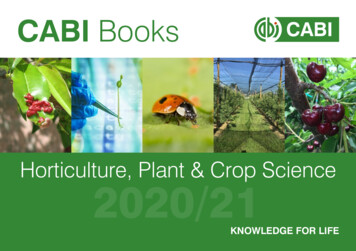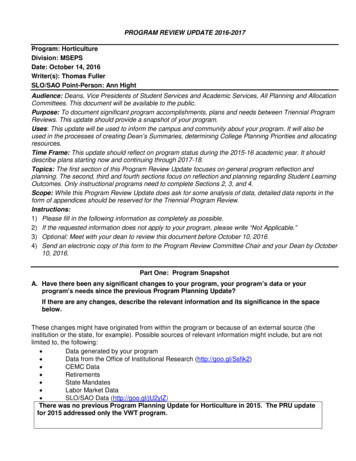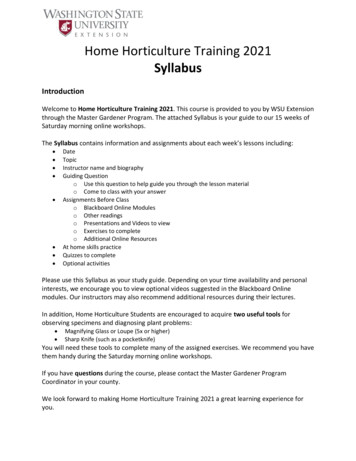
Transcription
Home Horticulture Training 2021SyllabusIntroductionWelcome to Home Horticulture Training 2021. This course is provided to you by WSU Extensionthrough the Master Gardener Program. The attached Syllabus is your guide to our 15 weeks ofSaturday morning online workshops.The Syllabus contains information and assignments about each week’s lessons including: DateTopicInstructor name and biographyGuiding Questiono Use this question to help guide you through the lesson materialo Come to class with your answerAssignments Before Classo Blackboard Online Moduleso Other readingso Presentations and Videos to viewo Exercises to completeo Additional Online ResourcesAt home skills practiceQuizzes to completeOptional activitiesPlease use this Syllabus as your study guide. Depending on your time availability and personalinterests, we encourage you to view optional videos suggested in the Blackboard Onlinemodules. Our instructors may also recommend additional resources during their lectures.In addition, Home Horticulture Students are encouraged to acquire two useful tools forobserving specimens and diagnosing plant problems: Magnifying Glass or Loupe (5x or higher)Sharp Knife (such as a pocketknife)You will need these tools to complete many of the assigned exercises. We recommend you havethem handy during the Saturday morning online workshops.If you have questions during the course, please contact the Master Gardener ProgramCoordinator in your county.We look forward to making Home Horticulture Training 2021 a great learning experience foryou.
Home Horticulture Training 2021SyllabusJanuary 9Welcome to Home Horticulture TrainingInstructor: Jennifer Marquis is Program Leader, WSU Extension Master Gardener Program, College ofAgricultural, Human and Natural Resource Sciences. Jennifer has been a WSU Master Gardener programleader for 13 years. She accepted the statewide coordinator position in May of 2019 after serving in a countyrole for 12 years. She has 20 years of experience working with non-profit organizations and volunteers todeliver on organizational mission. Her experience coupled with a B.A.S. in Non-Profit Management and a M.S.in Management and Leadership, make her well skilled as the leader of the world’s first Master GardenerProgram. She is known for her strategic thinking and for her ability to engage with diverse teams to createtrusting and durable community partnerships that lead to mission and vision success. She is atransformational leader who seeks to elevate the WSU Extension Master Gardener Program by engaginguniversity-trained volunteers to empower and sustain diverse communities with relevant, unbiased,research-based horticulture and environmental stewardship education.Basic Botany and Plant IDInstructor: Paula Dinius, Urban Horticulturist, WSU Extension Chelan County, began her career with WSUin 2004 in urban horticulture. She is a botanist and plant pathologist who shares her urban horticultureexpertise with the landscaping industry, local governments, and municipalities. Paula is also known for herwork in educating the WSU Extension Master Gardener Program volunteers.Guiding Question:What is the role of the plant’s flower and why is it important togardeners?Assignments Before Class:In Blackboard:Under heading Botany and Plant ID read: Chapter 1 Basic Botany Chapter 2 Plant NomenclatureIn Presentations and Videos watch: Lily Parts, run time: 1:18 Twig Growth, run time: 0:49 Apple Parts, run time: 1:18Complete the exercise: Leaf Characteristics (either interactive exercise or the WORD document.)Using Additional Online Resources: Flower Reproduction and Functionhttps://www.youtube.com/Recommended?v 7G9Jozhr7H0 (run time 12 minutes)At home practice observational skills: Using pages 8 & 9 in Chapter 2, look at a plant and verbally describe:ooStems and structureLeaf shape, arrangement, and edges (hint: you can look for leaf nodes on deciduousplants to determine leaf placement or check out house plants)Optional Activity: Dissect a flower to see the different reproductive parts (best - daffodils/jonquils).Complete Quizzes for Chapters 1 & 2Page 2 of 20
Home Horticulture Training 2021SyllabusJanuary 16Understanding PesticidesInstructor: Dale Whaley, Assistant Professor for Integrated Weed Management/Agriculture, has beenworking for Washington State University Extension for 16 years. He is currently assisting Douglas,Chelan, Kittitas, and Okanogan County residents with their agriculture and integrated weedmanagement needs. He has expertise in entomology (M.S., WSU), integrated pest management (IPM)(B.S., WSU), noxious weed control, invasive species, alternative cropping systems, and continues to workas a regional coordinator for the Washington State Integrated Weed Control Project.Guiding Question:What are the six steps you must follow in order to use any pesticide?Assignments Before Class:In Blackboard:Under heading IPM and Pesticides read: Chapter 20 Understanding PesticidesIn Presentations and Videos watch: Understanding Pesticides, run time: 40:38 Pesticide Safety, run time: 18:53Complete the exercises: Pesticide Label Terminology - check your answers Pesticides in Your CommunityUsing Additional Online Resources:WSU Extension Hortsense http://hortsense.cahnrs.wsu.edu/ Select Hortsense Factsheets, select Common Insects and Mites, and read howto manage slugs.National Pesticide Information Center http://www.npic.orst.edu/ Follow thedirections to familiarize yourself with this valuable resource. Check out all the tabs for information, especially Emergency tab to read aboutwhat to do with accidental poisonings. On the Home Page find the Interactive Map for contacts in your area. Familiarize yourself with Hazardous Waste drop off sites in your area.Complete Quiz for Chapter 20Page 3 of 20
Home Horticulture Training 2021SyllabusJanuary 23Soil Nutrition and Soil FertilityInstructors:Deirdre Griffin LaHue is an Assistant Professor of Soil Quality and Sustainable Soil Management at theWSU Northwest Washington Research and Extension Center (WSU NWREC) in Mount Vernon, WA. Herresearch interests focus on the impacts of agricultural practices on soil microbial communities and thefunctions they provide. She takes a systems approach to understanding dynamics of soil organic matter,microbes, and nutrients in agriculture to help improve the resilience of cropping systems. Deirdrereceived her M.S. and Ph.D. in Soils and Biogeochemistry from University of California, Davis, where shestudied the effects of soil amendments (e.g. compost and biochar) and irrigation management on soilcarbon and nitrogen dynamics, soil health, and system productivity and profitability. Originally fromMaryland, Deirdre enjoyed a previous career in ballet before earning her B.S. at the University ofMaryland, College Park in Environmental Science and Policy.Gabriel (Gabe) LaHue is an Assistant Professor of Soil Science with the Department of Crop and SoilSciences at Washington State University and based at Northwest Washington Research and ExtensionCenter (WSU NWREC) in Mount Vernon, WA. His research focuses on soil moisture management andirrigation scheduling, managing soils to improve soil-water relationships, soil fertility, and water-nutrientinteractions in diverse cropping systems, including blueberries, cider apples, forage crops, onions, andspinach seed.Guiding Question:Why is it important to get a soil test and analyze your soil makeupbefore adding fertilizers and soil amendments?Assignments Before Class:In Blackboard:Under heading Soils and Plant Nutrition read: Chapter 3 Soil Science Chapter 5 Plant Mineral Nutrition and FertilizersIn Presentations and Videos watch: Soil Texture by Feel Demonstration, run time: 6:03 Soil Sampling, run time: 5:27 Sponge Analogy, run time: 3:10 Soil Structure, run time: 1:55Open the Map of Washington State: Note the number of different soil regions. Find your region to see how it compares to the other regions of Washington.Complete the Soil Evaluation ActivityComplete Quizzes for Chapters 3 & 5Page 4 of 20
Home Horticulture Training 2021SyllabusJanuary 30Plant Health Care and IPMInstructor: Gwen Hoheisel is Regional Extension Specialist with Washington State University focusingon perennial fruit crops and more specifically sustainable pest management, blueberry horticulture, andapplication technologies. She has degrees in zoology from the University of Maryland and entomologyfrom Pennsylvania State University focusing on IPM and insect diversity.Guiding Question:You notice that one of your woody landscape plants has some damagedleaves. What do you consider before taking action?Assignments Before Class:In Blackboard:Under heading Soils and Plant Nutrition read: Chapter 4 Urban Soil ManagementUnder heading IPM and Pesticides read: Chapter 19 Plant Health Care and IPMIn Presentations and Videos watch: Principles of Pest Management, run time: 41:13 Intro to IPM, run time: 22:48Using Additional Online Resources:WSU Hortsense http://hortsense.cahnrs.wsu.edu/ In Common Cultural Problems look up the non-chemical management for:o Desiccating windo Drought damageComplete Quizzes for Chapters 4 & 19Page 5 of 20
Home Horticulture Training 2021SyllabusFebruary 6Diagnosing Plant ProblemsInstructor: Jenny Glass has managed the WSU Puyallup Plant and Insect Diagnostic Laboratory for thepast 20 years where she has honed her diagnostics skills on a wide range of plant pathology and insectidentification experiences. She spends hours under the microscope trying to find signs of fungalpathogens and scours the internet looking for plant and problem information. Her favorite part of thejob is interacting with clients and helping them learn about the management solutions to their plantproblems. She is known to quip “Take up another hobby other than your lawn – Western WA growsmoss, moles, and annual bluegrass better than turf on many sites.” She loves vegetable gardening,reading books, and hiking. Some of her favorite plant diseases include the destructive power of lateblight on potato and tomato, the sporulation of Entomophobia leaf spot on photinia, and the ringpatterns that develop when snapdragons become infected with the fungal disease rust.Guiding Question:In order to diagnose a plant problem and develop a plan of action, whatdo you need to know and consider?Assignments Before Class:In Blackboard:Under heading Plant Pathology and Plant Problem Diagnosis read: Ch 16 Plant Problem Diagnosis Diagnosis Worksheet Systematic Diagnosis PlanIn Presentations and Videos watch: Planting Depth, run time: 1:44 Leaf Scorch, run time: 1:14 Heat Stress, run time: 1:45 Drought Resistance, run time: 1:34 Animal Damage, run time: 2:00 transcript Identify Conifer, run time: 1:05 transcriptUsing Additional Online Resources:WSU Extension Publications https://pubs.extension.wsu.edu/ In Publications, select Gardening, then select Plant Pests and Diseases, read:o Assessing Tree Health – FS055EOptional Exercise: Download the Puyallup clinic intake form c1006.pdf Practice filling it out for a plant you find is having a problem. Even a partially filled outform will help your Master Gardener clinicians in helping you solve a problem.Complete Quiz for Chapter 16Page 6 of 20
Home Horticulture Training 2021SyllabusFebruary 13Lawns and Weed ManagementInstructors:Eastern WashingtonPaula Dinius, Urban Horticulturist, WSU Extension Chelan County, began her career with WSU in 2004in urban horticulture. She is a botanist and plant pathologist who shares her urban horticultureexpertise with the landscaping industry, local governments, and municipalities. Paula is also known forher work in educating the WSU Extension Master Gardener Program volunteers.Western WashingtonJim Kropf is currently the Natural Resources Program Director for WSU Extension. He is also theDirector of County Administration for the 40 extension offices across the state and the interim countyDirector for WSU Extension Pierce County. He has been a faculty member for WSU Extension for 41years. He was the Area Agronomist in Chelan and Douglas Counties for 14 years followed by four yearsas the Area Horticulturalist for Pierce and King Counties. In addition to providing technical productionskills for farmers, he focused on direct marketing, training new farmers, and on-farm research related tohorticultural crops. He continues to provide training for the Master Gardener Program. Jim was raisedon a small diversified farm in western Washington with a focus on small fruits. He has a B.S. and M.S. inAgronomy from Washington State University.Guiding Questions:What are good lawn management practices?What are the components of integrated weed management?Assignments Before Class:In Blackboard:Under heading Lawns read: Chapter 9 LawnsUnder heading Weed Management read: Chapter 17 Weeds and Weed ManagementIn Presentations and Videos watch: Weed ID, run time: 26:43Using Additional Online Resources:WSU Extension Publications https://pubs.extension.wsu.edu/ Download and save for reference:o Home Lawns – EB0482o Drought Advisory Lawns and other Turf – EB0684EWSU Hortsense .aspx Follow these steps to find out more on dandelions: menu “weed problems”,select dandelions, click on “dandelion” hyperlink.Complete Quizzes for Chapters 9 & 17Page 7 of 20
Home Horticulture Training 2021SyllabusFebruary 20EntomologyInstructor: Todd Murray, Entomologist and Extension Agriculture and Natural Resources ProgramDirector, is Director of the Washington State University Puyallup Research and Extension Center. Earninghis master’s degree in Entomology at WSU in 1996, Murray made his career in Extension, serving as acoordinator and educator in King and Whatcom counties, then director of Skamania and Klickitat CountyExtension. Since 2015, he has directed WSU Extension’s Agriculture and Natural Resource Program Unit,helping thousands of Washingtonians learn how to improve farm productivity, conserve naturalresources, and protect crops, forests, and streams.Guiding Question:What are the key features to understand about insects in order toproperly identify problems in the landscape?Assignments Before Class:In Blackboard:Under heading Entomology read: Chapter 14 EntomologyIn Presentations and Videos watch: Leafhoppers, run time: 1:46 Aphids, run time: 3:54 Leafcutter Bees, run time: 1:26 Leafhoppers, run time: 1:46Download and save as a reference: Insects in Your CommunityUsing Additional Online Resources:WSU Hortsense .aspx In menu on the left, under Search Factsheets By select Natural Enemies andPollinators. In the sub-category list check out a few of our predatory insects thathelp us in our yards.WSU Hortsense .aspx In menu on the left, under Search Factsheets By, select plant, pest, symptom. Inthe second box, type in “aphid” and see what comes up.WSU Gardening in Washington State http://gardening.wsu.edu/ Click on Wildlife and read the publication:o Pollination and Pollinator Protection – FS174EComplete Quiz for Chapter 14Page 8 of 20
Home Horticulture Training 2021SyllabusFebruary 27 for Eastern WashingtonHome Orchards and Small FruitInstructors:Home Orchards: Tianna DuPont is Tree Fruit Extension Specialist at the WSU Tree Fruit Research andExtension Center (WSU TFREC) and supported by Douglas, Grant, and Chelan Counties. Her programs for tree fruitgrowers are an important tool that helps them continue to thrive in a constantly changing environment. Hercurrent program areas include organic production; sustainable pest and disease management; soil and watermanagement; next generation tree fruit network; and increase knowledge and application of tree fruit BestManagement Practices (BMPs).Bernardita Sallato is Tree Fruit Extension Specialist at the WSU Irrigated and Tree Fruit Extension Center (WSUIAREC) in Prosser. Her program provides leadership in applied research, extension, and outreach for the PNW treefruit industry. Her goal is improving orchard efficiency and fruit production through horticultural managementpractices and technology. Her main areas of interest are: 1) soils and plant nutrition; 2) tree fruit stressmanagement; and 3) general horticultural practices for tree fruit production. Bernardita has a B.Sci. AgricultureEngineer, Horticulture and a M.Sci. Physiology and Fruit Production Area from PUC, Chile.Small Fruits: Jim Kropf is currently the Natural Resources Program Director for WSU Extension. He is also theDirector of County Administration for the 40 extension offices across the state and the interim county Director forWSU Extension Pierce County. He has been a faculty member for WSU Extension for 41 years. He was the AreaAgronomist in Chelan and Douglas Counties for 14 years followed by four years as the Area Horticulturalist forPierce and King Counties. In addition to providing technical production skills for farmers, he focused on directmarketing, training new farmers, and on-farm research related to horticultural crops. He continues to providetraining for the Master Gardener Program. Jim was raised on a small diversified farm in western Washington with afocus on small fruits. He has a B.S. and M.S. in Agronomy from Washington State University.Guiding Question:What must you consider when planning and maintaining good fruitproduction?Assignments Before Class:In Blackboard:Under heading Fruit Crops read: Chapter 7 Home Orchards Chapter 8 Berries and Small FruitsIn Presentations and Videos watch: Tree Fruit Insect Pests and Their Management, run time: 51:47 Increasing Light Exposure, run time: 1:10 Harvesting Apples, run time: 1:27 View any small fruit videos in which you have an interest.Complete the exercise: Tree Fruit ProblemsUsing Additional Online Resources:WSU Extension Publications https://pubs.extension.wsu.edu/ Under Publications in submenu Gardening, find:o Growing Small Fruits for the Home Garden (Home Garden Series) – EB1640(download electronic version for free)WSU Hortsense http://hortsense.cahnrs.wsu.edu/ In left menu select Hortsense Fact Sheets, select Tree Fruits and read about the insectsand diseases that might affect one of the fruits. In left menu select Hortsense Fact Sheets, select Small Fruits and read about the insectsand diseases that might affect one of the fruits.Complete Quizzes for Chapters 7 & 8Page 9 of 20
Home Horticulture Training 2021SyllabusFebruary 27 for Western WashingtonHome Orchards and Small FruitsInstructors:Home Orchards: Travis Alexander is a Postdoctoral Researcher in WSU Cider Program at theNorthwestern Washington Research and Extension Center (WSU NWREC) in Mount Vernon, Washington.Travis grew up in Southern California, earned a B.S. in Biochemistry at the University of California, San Diegoand an M.S. in Horticulture and Agronomy at the University of California, Davis. His masters’ research wasfocused on chilling injury in peaches for the fresh and canned fruit markets. His doctorate work focuses onthe postharvest implications, if any, of introducing mechanization in the harvesting of cider apples. Travis isfluent in English and Spanish and currently working on speaking Russian.Small Fruits: Lisa Wasko DeVetter is an Assistant Professor at WSU Northwestern Washington Researchand Extension Center (WSU NWREC) in Mount Vernon, Washington where she leads the state-wide SmallFruit Horticulture program. Originally from Iowa, Lisa developed her agricultural interests while spendingsummers on her family’s farm and helping her grandmother cultivate a diverse farmyard garden. Herhorticultural interests grew as she engaged in international development projects at Iowa State University(ISU), which is where she also earned her B.S. in biology and horticulture. She received her M.S. i
Maryland, College Park in Environmental Science and Policy. Gabriel (Gabe) LaHue is an Assistant Professor of Soil Science with the Department of Crop and Soil Sciences at Washington State University and based at Northwest Washington Research and Extension Center (WSU NWREC) in Mount Vernon,
